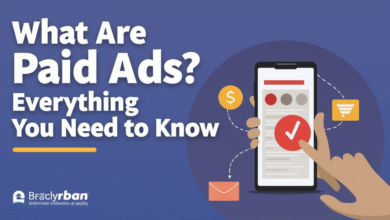risks of paid advertising

As digital marketing changes, businesses must know the risks of paid ads in 2024. Paid ads, like search engine marketing, can boost website traffic fast. But, they also pose dangers that can hurt your budget and reputation.
The State of Digital Marketing Report 2024 shows the importance of understanding paid ads. It points out the need to handle digital marketing’s complexity and competition. With rising ad costs and more people avoiding ads, the dangers of paid ads are clear.
We’ll look at the risks of paid ads, like wasting money, not reaching the right audience, ad fraud, and legal issues. Knowing these risks helps businesses make better choices. They can then find ways to avoid the problems of paid ads in the digital world.
Table of Contents
What is Paid Advertising and Its Current State
Paid advertising uses digital marketing strategies like search engine marketing (SEM) and pay-per-click (PPC) ads. It also includes ads on various platforms. The goal is to attract potential customers and encourage actions like visiting websites or making purchases.
Types of Paid Advertising Platforms
Big names in paid ads are Google, Bing, Facebook, Instagram, and LinkedIn. Google leads with about 84% of the search ad market. Advertisers also use Amazon, YouTube, and Microsoft Ads to find their audience.
The Evolution of Digital Advertising
The digital ad world has changed a lot. Now, ads can target people more precisely and measure results better. Marketers aim for sales, leads, and clicks, not just brand awareness. With more competition, they focus on segmenting audiences and personalizing ads to get the best return on investment.
Key Performance Metrics in Paid Advertising
- Click-through rate (CTR): The percentage of users who click on an ad after seeing it.
- Conversion rate: The percentage of users who take a desired action, such as making a purchase or submitting a lead form.
- Return on ad spend (ROAS): The ratio of revenue generated from an advertising campaign to the amount spent on that campaign.
Knowing and tracking these metrics helps advertisers fine-tune their ads. It boosts campaign success and guides decisions based on data for better outcomes.
“Embracing the evolution of digital advertising is crucial for businesses to stay competitive and reach their target audience effectively.”
Common Risks of Paid Advertising
Paid advertising comes with its own set of challenges and risks. Wasting budgets and attracting the wrong audience are just a few. A poorly run ad campaign can harm your brand’s reputation and marketing success.
One major advertising risk is wasting budgets. It’s wise to have a budget for at least 3–6 months. This allows the account to adjust to any initial issues. Daily budgets are set by dividing the monthly budget by 30.4 days. Some platforms might spend up to double the daily budget on a single day to avoid overspending.
Another challenge is attracting the wrong audience. For eCommerce, some companies use Google Shopping, while others prefer Meta platforms. Poor account setup or segmentation can lead to unprofitable results.
Creating a negative brand image is a big marketing pitfall. It can damage consumer trust and lead to backlash. Advertisers must be careful with ad placement and content to keep a positive image.
| Risk | Description | Mitigation Strategies |
|---|---|---|
| Wasted Budgets | Ineffective campaigns that fail to generate a positive return on investment | Allocate a sufficient budget for at least 3-6 months Carefully monitor daily ad spending to avoid overspending Optimize account structure and campaign segmentation |
| Audience Misalignment | Targeting the wrong demographic or consumer segment | Conduct thorough market research to understand your target audience Leverage platform-specific targeting options (e.g., Google Shopping, Meta platforms) Continuously monitor and adjust targeting strategies based on performance |
| Negative Brand Perception | Ads that create a negative association with your brand, eroding consumer trust | Implement robust brand safety measures to ensure ad placement and content alignment Monitor social media and online conversations to address any negative feedback promptly Establish clear guidelines and policies for ad content and placement |
To avoid these risks, advertisers need to know their audience well. They should also have strong brand safety measures in place. Keeping an eye on campaigns and making adjustments as needed is key. By being proactive, businesses can make their paid ads more effective and grow sustainably.
Budget Management Challenges and Financial Risks
Managing your ad budget well is key to marketing success. But, it’s not easy. You face challenges like hidden costs and measuring ROI. Paid ads can be tricky for marketers.
Hidden Costs in Advertising Campaigns
Ad costs can rise quickly due to hidden expenses. These include bad targeting, ad fraud, and extra fees. Keeping track of these costs is vital for a healthy budget.
ROI Measurement Difficulties
Measuring ROI can be tough. It’s easy to track immediate sales, but long-term effects are harder. You need a detailed plan to measure ROI well.
Budget Allocation Strategies
Spending your budget wisely is crucial. Try diversifying, testing, and optimizing your ads. A Google Economic Impact study shows businesses can get $8 in profit for every $1 on Google Ads. But, results vary by industry and campaign success.
| Budget Management Challenge | Potential Impact | Recommended Strategies |
|---|---|---|
| Hidden Advertising Costs | Overspending, Reduced ROI | Closely monitor targeting effectiveness Implement ad fraud detection measures Negotiate platform fees and costs |
| ROI Measurement Difficulties | Inability to Accurately Assess Performance | Utilize Marketing Mix Modeling (MMM) to understand causal relationships Backtest MMM forecasts for accuracy Leverage budget optimization tools to distribute budgets effectively |
| Effective Budget Allocation | Suboptimal Campaign Performance | Diversify spending across multiple platforms Continuously test and optimize ad placements Utilize scenario planning and iterative forecasting |
By tackling these challenges, you can manage your ad costs, measure ROI accurately, and allocate your budget wisely. This will help drive your marketing campaigns to success.
Ad Fraud and Security Concerns
In the fast-paced world of paid advertising, ad fraud is a big threat. Malicious actors use complex methods to trick advertising systems. This makes advertisers pay for fake activity instead of real user engagement. They use tactics like domain spoofing and pixel stuffing to cheat the system.
Reports say ad fraud costs a lot, with $84 billion lost in 2023. This number could hit $172 billion by 2028. Yet, only 23% of big marketers worry about ad fraud a lot. 14% don’t worry at all.
To fight ad fraud, starting with people-based data is key. Getting a full picture of prospects with data from different sources helps. Using intent data to find the best prospects and making media plans clear are also important. But, ad fraud is always a worry, showing we need to stay alert and take action to protect our ads.
| Fraudulent Practice | Description |
|---|---|
| Click Fraud | Generating fake clicks on ads using bots or click farms, making advertisers pay for useless clicks. |
| Bot Fraud | Using automated programs to act like humans and interact with ads, websites, or apps, making fake metrics without real conversions. |
| Mobile Ad Fraud | Using mobile devices and apps for fake installs, conversion fraud, or click spamming. |
| Ad Stacking | Putting multiple ads on top of each other in one ad spot, making advertisers pay for many impressions while users see just one. |
| Domain Spoofing | Acting like real websites to trick platforms into showing ads on bad or fake sites. |
The fight against ad fraud and security issues is crucial in digital advertising. Advertisers, agencies, and platforms must stay alert and use advanced tools. By doing this, we can protect our ads and make sure our budgets go to real, quality engagement.
Target Audience Misalignment Issues
Getting the right audience targeting is key for paid ad success. But, not hitting the mark can waste money and hurt campaign results. Problems often come from not doing enough research or using too broad categories that miss your perfect customers.
Geographic targeting issues can pop up from wrong location data or ignoring local tastes. Behavioral targeting faces hurdles like privacy and guessing what people want online.
Demographics Targeting Mistakes
Ads that don’t match the landing page can lose sales and waste budget. This can lead to ads not reaching the right people and not converting well.
Geographic Targeting Problems
Using your own data for ads can make them better and more personal. But, ad fatigue is a big problem, especially on Meta. Changing up ads and trying new things can keep people interested and avoid too much repetition.
Behavioral Targeting Challenges
Not tracking well can make it hard to see how ads are doing. This makes it tough to know if you’re getting a good return on investment. Ads that don’t hit the right people can lead to low ROI. So, it’s important to get better at targeting based on what people want, who they are, and what they like.
Knowing your target audience and doing demographic profiling well is crucial for geographic advertising. Understanding your audience and improving your targeting can make paid ads work better for your business.
Platform-Specific Advertising Risks
Advertising online can be tricky, with each platform having its own challenges. Google Ads, a big player, is often targeted by fraudsters. It’s key to have strong fraud detection. Social media sites face issues like fake accounts and bots, affecting how well ads work.
Changes in how platforms work can hurt ad performance suddenly. Relying too much on one platform makes you vulnerable. A strategy that uses many platforms helps avoid these risks and keeps results steady.
| Advertising Platform | Potential Risks | Mitigation Strategies |
|---|---|---|
| Google Ads | Fraud and click-based scams Algorithm changes affecting ad performance Intense competition driving up costs | Implement robust fraud detection and prevention measures Diversify advertising strategies across multiple platforms Continuously monitor and adjust campaigns based on performance |
| Social Media Platforms (Facebook, Instagram, Twitter) | Fake accounts and bot activity skewing metrics Algorithm changes impacting ad visibility and reach Reputational risks from associating with controversial content | Leverage advanced audience targeting and verification tools Diversify social media ad placements beyond a single platform Implement brand safety measures and content monitoring |
| Display and Video Advertising | Fraud and non-human traffic inflating impressions Lack of transparency in ad placements and inventory quality Difficulty in measuring the true impact of campaigns | Partner with reputable ad networks and exchanges Utilize advanced viewability and brand safety monitoring tools Implement robust attribution models to accurately track performance |
Knowing the channel-specific risks in different advertising platforms helps marketers. They can then create a multi-platform strategy. This strategy helps avoid risks and makes paid ads more effective.

Brand Safety and Reputation Management
In the world of paid ads, keeping your brand safe and managing its reputation is key. Brands aim to connect with their audience but must be careful about where their ads appear. This ensures their message stays true to their values and keeps a good image in the public eye.
Ad Placement Concerns
Where ads are placed is very important for brand safety. Ads next to bad or controversial content can harm a brand’s image. For instance, in January 2020, Planters Peanuts had a crisis when their ad coincided with Kobe Bryant’s death. This shows the dangers of not choosing the right ad spots.
Content Association Risks
Brands also need to watch what they’re associated with. Being linked to things that go against their values or what their audience expects can hurt their reputation. To avoid this, brands must manage their ads carefully and keep an eye on them in real-time.
Big platforms like Meta, LinkedIn, TikTok, Twitter, and YouTube have tools to help with this. These tools help brands make sure their ads are in the right places and not near bad content.
Keeping your brand safe and managing its reputation is vital for ad success. By focusing on where ads are placed and what they’re near, brands can grow their trust with customers. This leads to better business results.
Compliance and Legal Risks
Marketers face a complex world of advertising rules. Not following these rules can lead to big fines, legal troubles, and harm to your reputation. It’s key to know the rules and have strong compliance steps to avoid legal risks.
Ad policy violations are a big worry. Breaking these rules can cause ads to be removed, your account to be suspended, or even lead to lawsuits. Things like illegal products, dangerous items, and offensive content are not allowed. Also, making misleading claims about products or services can get you in big trouble with the law.
Trademark and intellectual property rights are also a legal risk. Using someone else’s trademark without permission can lead to lawsuits. It’s also important to make sure landing pages meet destination requirements, offering a good user experience and being relevant to the ad.
Privacy and data protection are getting more attention. Following data protection laws like GDPR and CCPA is a must. Advertisers also need to be careful when advertising to children, following laws like COPPA.
The financial services industry has strict rules for financial promotions. These rules are in place to stop fraud and protect consumers. Breaking these rules can lead to huge fines, like the $550 million fine Goldman Sachs got for misleading investors.
To stay on the right side of the law, advertisers should check ad policies often, do legal audits, train their teams, and get advice from legal experts. By focusing on compliance and legal issues, marketers can confidently move through the advertising world and avoid expensive mistakes.
“Compliance and legal risks are not just a box to check, but a strategic imperative for modern marketers. Investing in robust compliance processes can protect your brand’s reputation and safeguard your advertising investments.”
Data Privacy and Consumer Trust Issues
As a marketer, you face big challenges in data privacy and keeping consumer trust. The General Data Protection Regulation (GDPR) and other laws worldwide have changed how you handle consumer data. It’s key to protect user data well to follow the rules and keep your audience’s trust.
In the US, 87% of adults take charge of their personal data, and 64% think brands should protect it. With 422 million people affected by data breaches in 2022, trust in brands has dropped. It’s vital to be open about how you use data and let users control their info to win back trust.
With 68% of the global population worried about online privacy, and 86% of US consumers concerned about data privacy, your skills in this area are crucial. Getting the right consent and giving your audience control over their data shows you care. This builds a strong, lasting relationship with them.
FAQ
What are the common risks of paid advertising?
Paid advertising can lead to wasted budgets and attracting the wrong audience. It can also harm your brand’s image. Additionally, there’s a risk of ad fraud, like domain spoofing and pixel stuffing.
How can businesses effectively manage their advertising budgets?
To manage budgets well, spread ads across different platforms. Always test and optimize your ads. Also, measure your return on investment (ROI) to avoid wasting money on ineffective ads.
What are the key types of paid advertising platforms?
Paid advertising platforms include search engine marketing (SEM), social media ads, and display ads. Google is the biggest player in search ads, with an 84% market share.
How has the evolution of digital advertising impacted the industry?
Digital advertising has grown more targeted but also more competitive. Now, advertisers focus on measurable results like sales and leads. This shift is due to increased user awareness of ads.
What are the key performance metrics in paid advertising?
Important metrics are click-through rates, conversion rates, and return on ad spend (ROAS). Advertisers now aim for sales, leads, and clicks over just brand awareness.
How can target audience misalignment impact paid advertising campaigns?
Not matching your audience can waste your ad budget and hurt campaign results. Mistakes often come from not researching your audience well or relying too much on broad categories.
What are the risks associated with specific advertising platforms?
Each platform has its own risks. Google Ads is a big target for fraudsters. Social media faces issues with fake accounts and bots. Algorithm changes can also suddenly affect ad performance.
How can brand safety and reputation management be a concern in paid advertising?
Ads appearing with inappropriate content can harm your brand. This is known as content association risk. It happens when your brand is linked to topics that don’t match your values or audience expectations.
What are the compliance and legal risks in paid advertising?
Advertisers must follow laws on data privacy and consumer protection. Not following these can lead to fines and damage to your reputation. Key areas include truthful ads, proper disclosures, and following platform policies.
How do data privacy and consumer trust issues impact paid advertising?
Laws like GDPR have changed how advertisers handle data. They must be transparent, get consent, and give users control over their data. This keeps trust and follows regulations.



